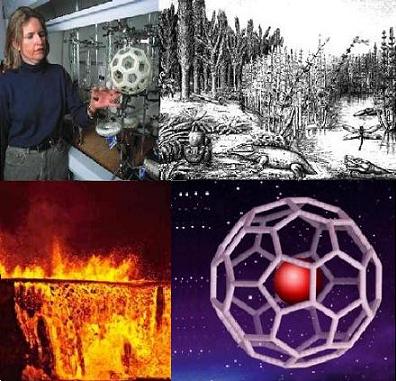250 million years ago something unknown wiped out most life from the face of the earth. Now scientists are finding clues to the mystery buried inside tiny capsules of cosmic gas
Patrick L. Barry, FIRST SCIENCE website, translated by: Eli Ben David

Direct link to this page: https://www.hayadan.org.il/armagadon250my.html
It was almost the perfect crime.
A certain criminal - or criminals - committed murder on a scale unparalleled in the history of the world. They left few clues to their identity. And they buried all the evidence under layers upon layers of the earth. An unsolved case that has lasted for many years, I mean: 250 million years.
But now pieces are starting to come together to pay, thanks to a team of detectives from a NASA budget who found the "fingerprint" of the villain. Or at least of one of the accomplices.
The most terrible event has been lost in the forgotten depths of time for a long time. Only recently paleontologists, like travelers on an unmarked grave in the forest, discover an amazing pattern of fossil evidence: at a certain point beneath the accumulation of earth, the rock shows the signs of an ancient world infested with life. Several layers above this point are signs of life that have almost completely disappeared.
Somehow most of life on Earth was extinct in a geological eye about a year before 250.
Scientists call this: "the Triassic-Permian extinction" or "the great death" (note: Triassic: geological era, Permian: in geology - of the Permian period in the Paleozoic era - ABD) - without confusing it with the more familiar extinction: The "tertiary cratonic extinction" that marked the end of the dinosaur era, 65 million years ago.
What happened in the Triassic-Fermitic period was much worse: no species of life was saved from the destruction. Trees, shrubs, lizards, ancient mammals, insects, fish, mollusks and bacteria. Almost all of them were extinct. Approximately 9 from 10 marine strains and 7 from 10 dry-dwelling varieties have disappeared. Life on Earth is almost over.
Scientists have proposed many possible causes for the "Great Death": severe volcanic eruptions, a nearby supernova, environmental changes shaped by the formation of a supercontinent, the devastating impact of a giant asteroid - or some combination of all of these. It is difficult to prove which of the theories is correct - the traces have cooled in the last quarter of a billion years: most of the evidence has been destroyed.
"These rocks have been through a lot geologically and they usually don't preserve the boundaries (of the extinction) well," says Luann Becker, a geologist at the University of California, Santa Barbara. Indeed, very few 250 million year old rocks remain on Earth. Most of them are reclaimed by the tectonic activity of our planet.
Intrepidly made, Becker led a NASA-funded team of scientists to sites in Hungary, Japan and China where such rocks were exposed and still exist. Evidence was found there that told of signs of a collision between our planet and an asteroid measuring 6 x 12 km - in other words, as big or bigger than Mount Everest.
Many paleontologists have expressed skepticism about the theory that an asteroid caused the extinction. Early studies suggest that such extinction occurred gradually over millions of years - not as the effect of a sudden violent event. But as the method of dating extinctions advanced, estimates of extinction durations were reduced from millions of years to between 8 and 100 years. This is just a geological blink of an eye.
"I think that paleontologists are now closing a circle and leading the way to the conclusion that the extinction was sudden and sharp," notes Becker. "Life disappeared quickly on a geological time scale, and it takes something catastrophic to do that."
Such evidence is purely circumstantial - it doesn't actually prove anything. Becker's evidence, however, is more direct and convincing.
Deep within the rocks of the Triassic-Permian era, Becker's team found football-shaped molecules called fullerenes or buckyballs that had traces of helium and argon trapped inside. These carried within them an unusual number of 36Ar and 3He atoms - isotopes that are more often found in space than on Earth. Something like a comet or an asteroid must have brought these "balls" (capsules) to our planet.
Becker's team had previously found such gas-bearing capsules in rock layers associated with two violent events: the 65-million-year-old Craton-Tertiary impact and the 1.8-billion-year-old Sudbury Crater impact in Ontario, Canada. They found similar gas-bearing capsules in some meteorites as well. After all, these clues make a convincing case that a cosmic cause hit the Earth during the "Great Death".
But was the asteroid the murderer or was he just an accomplice?
Many scientists believe that life was already in a state of struggle when the asteroid in question already arrived. Kedah was tormented by severe volcanic eruptions. In the area known today as Siberia, 1.5 million cubic kilometers of lava flowed out of a huge fissure in the Earth's crust. (For comparison: Mount St. Helens released about one cubic kilometer of lava in 1980). Such an eruption will destroy-burn vast expanses of land, cause atmospheric clouding with dust, and create an alternative climate of the greenhouse effect.
The geography of the world was also constantly changing. Tectonic plates pushed the continents to form a pattern of the Pangea (hypothetical continent from which the seven continents separated) and the super-ocean, Panthalassa. Weather patterns and ocean currents, many coastlines, and the shallow marine ecosystems disappeared and the sea level dropped.
"If all of a sudden so many different things have happened to life," says Becker, "and all of a sudden a rock the size of Mount Everest is thrown at them - wow, that's really bad luck"
But was the "crime" just an accident? maybe yes. Even so, it is wiser to identify the suspects - a process in progress - before it happens again...
They knew cosmic collisions
For the article on the FIRST SCIENCE website
https://www.hayadan.org.il/BuildaGate4/general2/data_card.php?Cat=~~~786875485~~~35&SiteName=hayadan
